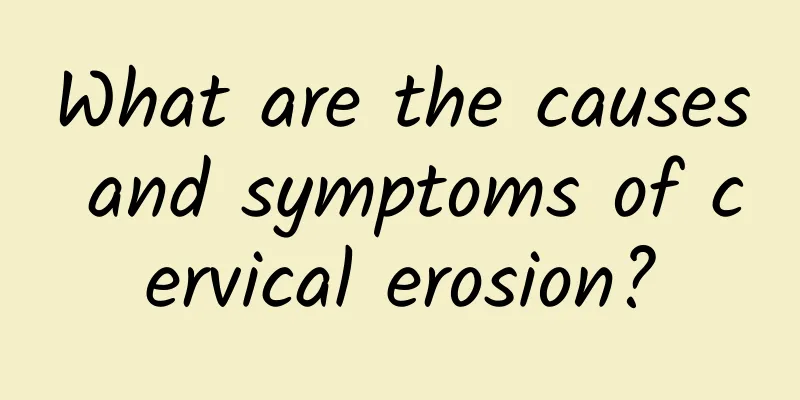What are the causes and symptoms of cervical erosion?

|
Cervical erosion is a physiological change of cervical epithelial cells, not a disease, and usually does not require excessive treatment. Its causes include changes in hormone levels, cervical inflammation, etc. Common symptoms are increased vaginal discharge or abnormal bleeding. Treatment methods are selected according to specific circumstances. Mild symptoms can be treated with observation or medication, while severe cases require physical therapy or surgery. 1. Causes of cervical erosion Changes in hormone levels are one of the main causes of cervical erosion. When women are in adolescence, pregnancy, or taking birth control pills, their estrogen levels rise, causing the columnar epithelium in the cervical canal to move outward, forming an erosive appearance. Cervical inflammation may also cause erosion, such as chronic cervicitis or infectious cervicitis, which stimulate cervical epithelial cells for a long time and cause them to change. Frequent sexual intercourse, multiple miscarriages or childbirth may also cause mechanical damage to the cervix, increasing the risk of erosion. 2. Common symptoms of cervical erosion The symptoms of cervical erosion vary from person to person, and some women may not experience obvious discomfort. Common symptoms include increased vaginal discharge, which may be yellow or have an odor. A small number of patients may experience contact bleeding, such as bleeding after sexual intercourse or after a gynecological examination. If accompanied by infection, it may be accompanied by lower abdominal pain or discomfort in the lumbar sacral region. These symptoms are not specific to cervical erosion and require a gynecological examination to confirm the diagnosis. 3. Treatment of cervical erosion Patients with mild cervical erosion and no symptoms usually do not need special treatment and only need regular follow-up. Drug treatment is suitable for patients with inflammation. Commonly used drugs include antibiotics such as metronidazole, anti-inflammatory drugs such as Baofukang suppositories or Chinese medicine preparations such as Fuyankang tablets. Physical therapy is suitable for patients with obvious symptoms or large areas of erosion. Common methods include laser therapy, cryotherapy or electrocautery. Surgical treatment is suitable for very rare cases. If the erosion is severe and recurrent, cervical conization or LEEP knife can be used for treatment. Cervical erosion is a common physiological phenomenon and does not require excessive treatment in most cases. Women should undergo regular gynecological examinations to promptly detect and treat potential problems. If symptoms such as abnormal vaginal discharge and contact bleeding occur, seek medical attention in a timely manner for a clear diagnosis and appropriate treatment. Maintaining good living habits and avoiding excessive cleaning or the use of irritating products can help maintain a healthy cervix. |
<<: Is cervical hypertrophy related to men
>>: What medicine should I take for endometritis and cervicitis
Recommend
Does running hurt your knee joints? Misunderstood! Being overweight
According to statistics from the Republic of Chin...
Acupuncture and moxibustion for treating chronic pelvic peritonitis
Pelvic peritonitis is a common gynecological dise...
Can you get pregnant if you have sex during your period?
Women can get pregnant if they have sex during me...
Doubt! What are the symptoms of adnexitis?
What are the symptoms of adnexitis? Expert introd...
What are the diagnostic criteria for female dysmenorrhea?
Any disease needs to be correctly diagnosed befor...
Most women with breast cancer cells will have these 5 symptoms, so be careful
Ms. Li was tidying her clothes in front of the mi...
Why is Bartholinitis difficult to cure?
In daily life, many female friends are troubled b...
What you need to know about nursing care after having an ectopic pregnancy
Pregnant women are very likely to suffer from ect...
What are the causes of uterine fibroids?
Uterine fibroids mainly refer to gynecological di...
Low-calorie snacks that will make you addicted! Homemade almond cheese
Every afternoon, when office workers are exhauste...
What medicine can be used to treat uterine fibroids?
What medicine can be used to treat uterine fibroi...
NG weight loss can easily lead to aging. 6 foods you must eat to lose weight and fight aging
After finally successfully getting rid of excess ...
Exercise and massage to get rid of stubborn fat and say goodbye to postpartum belly
At the end of the year, many women are happy to b...
What are the symptoms of chronic adnexitis?
Chronic adnexitis is a type of adnexitis, and man...
Bloggers love eating this way! Recipe for thin face (Part 2)
Ai Ai Wo, who is not fat, once tried the legendar...









